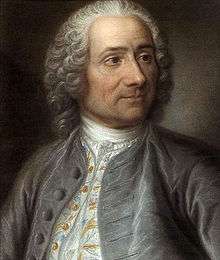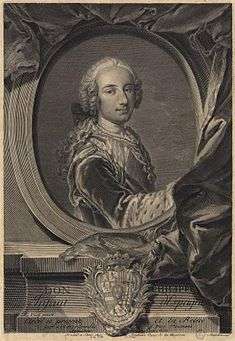Louis René Vialy
| Louis-René Vialy | |
|---|---|
 Presumed self-portrait of Vialy. | |
| Born |
Vialy 1680 Aix-en-Provence |
| Died |
17 February 1770 Paris |
| Nationality | French |
| Known for | painting |
| Movement | Classicism |
Louis-René Vialy (1680 - 17 February 1770), also spelled Vially, Viali or Viallis, was a French painter.
Life

The son of Jacques Vialy, a Sicilian painter born at Trapani but who moved to Provence, Louis-René Vialy was born at Aix-en-Provence. He began his career decorating sedan chairs, as attested by Mariette, who wrote that "it was a very popular taste in Provence to have ornamented sedan chairs".[1] His father was naturalised as a French subject by letters registered at the cour des comptes of Aix-en-Provence in 1720[2] and died in Aix on 25 December 1745 aged 95. He was buried the following day in the old parish church of La Madeleine, beside Jean-Baptiste van Loo who had died on 29 September the same year.
Louis-René at first studied under his father and very often attended the Vernets' studio - Antoine Vernet, decorative painter, was a family friend of Louis's father. Louis-René is normally named as the tutor of the young marine painter Joseph Vernet[3] but this was actually Jacques.[4] Louis-René in 1752 painted a pastel portrait of Vernet[5] and owned several paintings by him, such as the two exhibited at the 1757 Salon.[6] Mariette also cites him as tutor to the engraver Jean-Joseph Balechou.

Vialy seems to have set himself up in Paris around 1750,in rue d’Argenteuil, behind the Church of Saint-Roch. His style as a portrait painter influenced and was influenced by the salons of the Académie Royale de Saint-Luc, where he exhibited in 1752, 1753 and 1756 with the titles "peintre du Roi" and member of Académie de Saint-Luc. At first, however, he worked for the famous portraitist Hyacinthe Rigaud, in whose studio he was found in 1712 and in 1714 under the name "Vial".[7] He was then only 32. This trip does not seem today to be apochryphal, for relationships are known between the Catalan painter and the Van Loo family,[8] during his trip to Lyons then to Paris.[9] On his death, Louis-René Vialy was still on rue des Aveugles, in the parish of Saint Sulpice, above a barber's shop.
Style
Vialy seems to have mainly worked in pastel, though some works by him in oil on canvas are known. In his Dictionnaire des Pastellistes, Neil Jeffarès describes the images created by Vialy as "easily recognizable : not very expressive like those by Allais, they are distinguished by a certain sweetness. [...] The eyes are liquid with the light of oils in the white point quite high to the left. He had a distinctive treatment of fabrics with tight folds and reflections". Vialy's pastel technique corresponded to the taste of his time, inheriting his attitudes to 3/4 length portraits from his contemporaries and from Louis Vigée. In contrast, his canvases adopt poses which owe a clear debt to Rigaud, such as his Portrait of a woman as Hebe (sold in 2007), and other artists. This is notably the case in his portrait of the regent,[10] after the 1717 painting of him by Jean-Baptiste Santerre, of which one copy is now held at the Prado in Madrid.[11]
Works


Vialy mainly exhibited at the Salos of the Académie de Saint-Luc
1752 Salon
- 230. Portrait of M. le Comte de Vance, Colonel of the Régiment Royal Corse, Maréchal de Camp of His Majesty's Armies.[12]
- 231. Portrait of Angélique-Louise La Rochefoucauld (1733–1794), vicomtesse de Vence as a Vestal Virgin. Pastel, 49 x 59 cm. Signed "Vialj / pinxit 1751 - ". Sold in Paris, Pascal Blouet, 26 February 2006, lot 15.
- 232. Portrait of M. Duriny, His Holiness’ Nuncio to the Court of France.[13]
- 233. Portrait of M. le Comte de Bonneval, pasha (entitled to three tails), Governor of Karaman.
- 234. Portrait of M.***
- 235. Portrait of M. de***
- 236. Portrait of Mademoiselle*** as a Muse, with all the attributes of Melpomene and Thalia, sitting at the foot of Mount Parnassus
1753 Salon
- 133. Portrait of Dom Philippe, Infante of Spain, Duke of Parma.[14]
- 134. Portrait of M. le Chevalier de Perrin.[15]
- 135. Portrait of M. Danthoine, Treasurer & [premier] Écuyer to Madame the Infanta, Duchess of Parma.
- 136. Portrait of M. Duchesneau, Knight of the Ordre Hospitalier de Saint-Lazare.[16]
- 137. Portrait of M. Desilant.
- 138. Portrait of M. Destourettes, Agent of the Town of Avignon.[17]
- 139. Portraits of M. Franque, Architect of the Hôtel Royal des Invalides[18] and his wife.
- 140. Portrait of M. Hemmery.[19]
- 141. Double Portraits of Mme de Torram, and her brother. Portrait of Mademoiselle ***, dressed as an ancient Greek
1756 Salon
- 87. Three sketches of mythological scenes. The first shows Diana surprising the sleeping shepherd Endymion; the second shows Clytie's metamorphoses into a sunflower; the third shows Vulcan and Venus in the Forges of Lemnos, with the Cyclopes forging Achilles' weapons; canvas of 20.
- 88. Four paintings of seascapes, landscapes and four historic scenes, figures and animals. The seascape shows sunset; a vessel entering a port, with others at anchor; other buildings, ships, barks and chalops, figures of different nations on the quay and shores. All these make up canvas of 40.
- 89. Two high paintings, canvas of 20.
- 90. Seascape with sunrise, canvas of 8, made for the cabinet of M. le Comte de Vance.
- 91. Portrait of Madame la Duchesse de Lauraguay, dressed as a Cordelière, in pastel, canvas of 20.
- 92. Six small paintings of seascapes and landscapes, one of sunrise, the others of sunset, and a clair de Lune, all with figures; canvas of 8, 6 & 4.
- 93. M. le Cardinal d'Uriny, former Nuncio to France, pastel on canvas of 12.
- 94. Portrait of Madame la Comtesse de la Guiche, as a Naiad, oils, canvas of 25.
- 95. Annibal Camoux, born 1638, in oils from life, at Marseille, at the age of 112 years [sic], now 118 years, as fresh and well as he is shown in his Portrait. Part of these paintings belong to the painter.[20]
- 96. A Painting for M. le Comte de Vance, showing a Sea Fort with several Figures, with the Sun appearing to set in the Sea, canvas of 8.
Other
- Portrait of Philippe d’Orléans, Regent of France. Oil on canvas, 133 x 90 cm. Signed and dated bottom right "fecit par R. Vialy 1718".
- Portrait of a young woman as Hebe. Oil on canvas, 67 x 55 cm. Signed and dated bottom left "L. R. Vialj pinxit / 1753". Sold in Paris, hôtel Drouot, Piasa, 22 June 2007, lot. 97.
- Presumed portrait of madame de Musset. Pastel, 58,5 x 47,5 cm. Signed and dated 1751 bottom right. Sold in Paris, hôtel Drouot, 17 June 2005, lot. 80.
- Portrait of a man in blue, called Self-portrait (Neil Jeffarès). Pastel, 46 x 38 cm. Signed and dated bottom left : « Vialy pinxit 1742 ». Auctioned in Lille, Mercier & Cie, 15 December 2001, lot. 358 (not bought) ; sold in Paris, May Duhamel & Associés, 6 June 2004, lot. 296.
- Portrait of Joseph Vernet, painter. Pastel, dated and signed "L. R. Vialj / pinxit / 1752". Paris, musée de la marine.
Notes
- ↑ Pierre-Jean Mariette, Abecedario de P.-J. Mariette et autres notes inédites de cet auteur…, work published by Ph. de Chennevières et A. de Montaiglon, 6 vol., Paris, 1851-1860
- ↑ Reg Papyrus, fol. 216. Cited in Roux Alphéran, 1846, I, p. 86
- ↑ N. Jeffarès, 2006, p. 338.
- ↑ Lagrange, 1864, p. 5-6.
- ↑ Paris, musée de la Marine
- ↑ "Two paintings, each two foot six pouces by two foot – n° 66. One showing storm at sea ; N°67. The other showing a landscape with waterfall. These canvases belong to M. Viali. » cf. Lagrange, 1864, p. 464.
- ↑ J. Roman, 1919, p. 165.
- ↑ Still little known, the works of the Van Loo family are often misattributed to Rigaud - these include the portrait of a man now in the Museum of Fine Arts in Boston (Inv. 37.1211), signed "JEAN VANLOO" and in fact by Jean Van Loo (active 1682-94), also previously attributed to Jean-Baptiste Van Loo…
- ↑ Rigaud suggested Louis-Michel Van Loo in 1737, when he was trying to find a painter to the Spanish court.
- ↑ Provenance : Vente d'une grande collection princière et divers, Paris, Drouot Montaigne, Picard, 22 June 1992, image of lot. 10.
- ↑ Exhibition catalogue L'Art européen à la Cour d'Espagne au XVIIIe siècle, Paris, 1979, image n° 79.
- ↑ Jean Alexandre Romée de Villeneuve-Vence, marquis de La Garde-Adhémar (Vence 1727 - Aix-en-Provence 1776). He married the model on 24 May 1751.
- ↑ Mentioned as number 12 in the inventory made after Vialy's death, with the title "Cardinal de Ligny. Pastel, glazed and with a gilded border". He was papal nuncio to France from 1744 and a cardinal from 1753 onwards.
- ↑ Engraved by Jean-Joseph Balechou between 1740 and 1764.
- ↑ Denis-Marius de Perrin (1682-1754), natif d'Aix-en-Provence, chevalier de l'ordre royal et militaire de Saint-Louis, ami de la famille se Simiane et éditeur d'un Recueil de lettres choisies pour servir de suite aux Lettres de Madame de Sévigné à Madame de Grignan, sa fille, Paris, Rollin, 1751.
- ↑ Jean Odile Martin, known as "Martin du Chesneau", captain in the régiment de Piémont-Infanterie, commander of the Ordre de Saint Lazare.
- ↑ Joseph-César de Villeneuve, seigneur de Tourettes. Mentioned in the posthumous inventory as number 12 (36 livres).
- ↑ Neil Jeffarès hesitated between identifying Jean-François Franque (1689-1758) (more often read as Jean-Baptiste Franque, 1683 - 1758) or his son François II (1710 - 1793), François II. However, only François II Franque worked in Paris and bore the title of architect of the Hôtel Royal des Invalides.
- ↑ Director of the Académie de Saint-Luc
- ↑ "We must keep coming back to the Portrait of Annibal de Marseille died 18 August 1759 aged 122, born in the reign of Louis XIII, on 10 May 1638, the same year as Louis XIV. He continually served as a soldier in the gallies. He was painted in 1748 from life in Marseille by M. Viali, Peintre du Roi who had the honour of successfully painting His Majesty in 1716. The image was engraved by M. Lucas, an engraver in Paris. He sold the prints at la Veuve Chereau, rue St. Jacques ; chez Joulain, quai de la Ferraille ; chez Buldet, rue de Gêvres & chez M. Viali, Peintre, Rue d'Argenteuil derrière St. Roch. » Mercure de France, December 1759, p. 172.
Bibliography
- (French) Roger-Armand Weigert, « Testament 19 août 1767 et inventaire après décès de Louis-René Vialy: Louis-René Vialy », in the Bulletin de la Société de l'Histoire de l'Art Français, Paris, 1931, pp. 146–58 (Archives Nationales, vol. LXV, 13 mars 1770).
- (French) Roux Alphéran, Les rues d’Aix ou recherches historiques sur l’ancienne capitale de Provence par Roux-Alpheran, Aix, 1846.
- (French) Neil Jeffares, Dictionary of Pastellists Before 1800, Unicorn, 2006, p. 338.
- (French) Léon Lagrange, Joseph Vernet et la peinture au XVIIe siècle : Avec le texte des Livres de raison, et un grand nombre de documents inédits, Paris, Didier, 1864.
- (French) J. Guiffrey, Livrets des expositions de l’Académie de Saint-Luc à Paris, pendant les années 1751, 1752, 1753, 1756, 1762, 1764 et 1774, avec une notice bibliographique et une table, Paris, Baur et Détaille, 1872.
External links
- Entry in dictionary of pastellists
- (French) Article on the painting of the comtesse de Vence on the LOF site